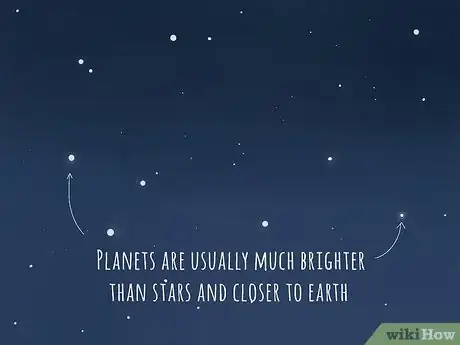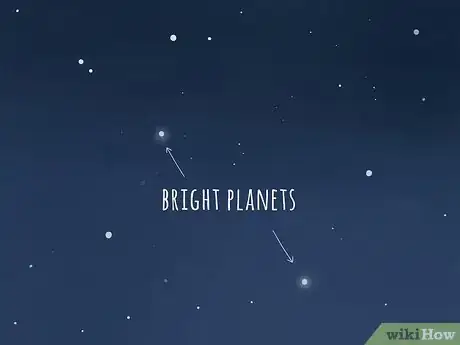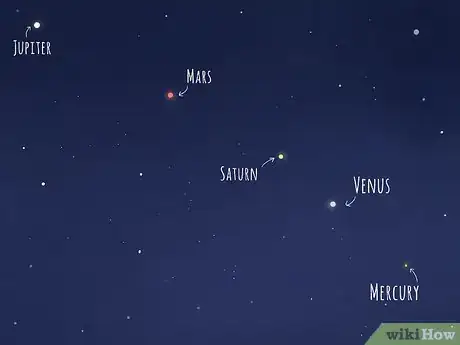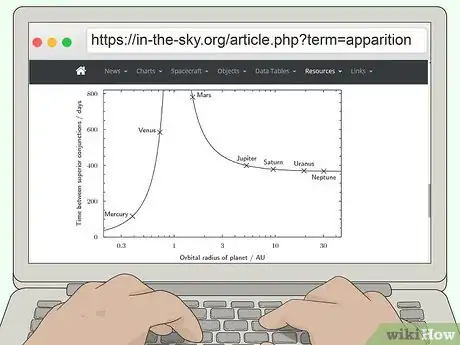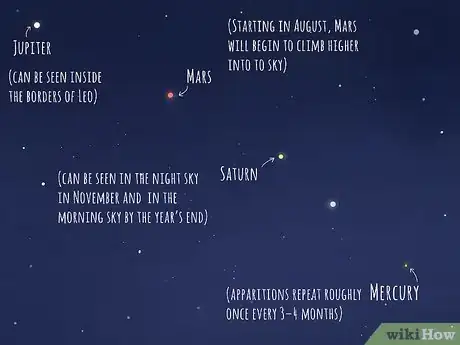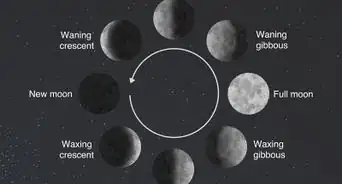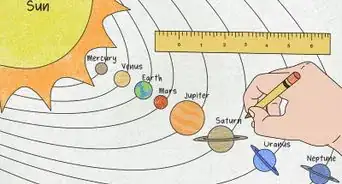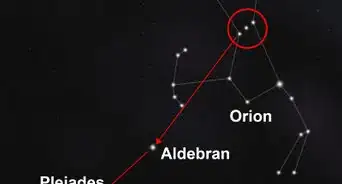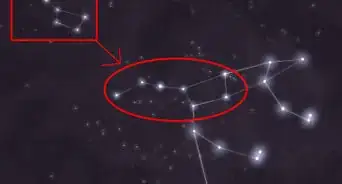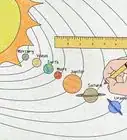wikiHow is a “wiki,” similar to Wikipedia, which means that many of our articles are co-written by multiple authors. To create this article, 19 people, some anonymous, worked to edit and improve it over time.
wikiHow marks an article as reader-approved once it receives enough positive feedback. In this case, 89% of readers who voted found the article helpful, earning it our reader-approved status.
This article has been viewed 437,141 times.
Learn more...
Finding planets in the night sky is a rewarding ability that lets you have a deeper knowledge of the universe—if you know what you are looking for! Because the night sky is an ever-changing display, you'll have to learn how to distinguish planets from non-planets when you look up. What you see will also depend on where you are on Earth, what time of year or night it is when you observe, and if you are using just your eyes or a special instrument to see. With all that in mind, the next time you look out into the night sky, you might be able to make out another planet!
Steps
Knowing What to Look For
-
1Distinguish stars from planets. Planets are usually much brighter than stars. They are closer to earth so they begin to look more like a disk, rather than a tiny dot.[1]
-
2Look for the bright planets. Although some of the planets may be in their apparition period, they may be harder to see if they aren’t one of the brighter planets. Jupiter and Saturn will always be the easiest to see.Advertisement
-
3Know what color you’re looking for. Each planet reflects the light of the sun differently. Know what color you’re looking for in the night sky.[2]
- Mercury: this planet twinkles, flashing a bright yellow color.
- Venus: Venus is often mistaken for a UFO because it is large and silver.
- Mars: this planet is a reddish color.
- Jupiter: Jupiter glows white throughout the night. It is the second brightest point of light in the night sky.
- Saturn: a smaller planet that is yellowish-white in color.
Looking in the Right Spot
-
1Learn how the lights affect the sky. It is easier to see the stars and planets in the night sky if you live in a rural area. If you’re in the city, it will be much more difficult to see them because of light pollution. Try to find a spot away from stray light that shines off of buildings.[3]
-
2Look in the right part of the sky. The planets are rarely near one another in the night sky. Knowing where to see them is very important. A great way to find them is to locate them when they appear as part of a constellation.[4]
- Mercury: Mercury will be visible near the Sun. You’ll lose it in the Sun’s glare for most of the year, but it will return to view in the middle of August.
- Mars: look low in the morning sky, Mars moves eastward.
- Jupiter: Jupiter is always located very far away from the sun.
- Saturn: look low in the Libra constellation to see this bright planet.
-
3Take your position on Earth into consideration. The planets may have an apparition period but may earlier in the eastern hemisphere and later in the night in the western hemisphere. When you look at the apparition periods, take into consideration what part of the earth you’re on.
Looking at the Right Time
-
1Find your planet’s apparition period. The apparition period is the time that your planet is visible. It can last anywhere from a few weeks to almost two years. You can look these up in most astronomy catalogues to figure out when your planets are visible.[5]
-
2Know what time to look. Most of the planets are most visible as the sky gets dark (dusk) or as the sky begins to brighten again (dawn). However, looking for them in the night sky is also possible. You have to look very late at night, when it is incredibly dark out.[6]
-
3Know when your planets are visible each night. Combine their apparition period with the time that they are most visible to determine when will be the best time to see the planet you’re looking for.[7]
- Mercury: this planet is visible multiple times a year. This year, it will still be visible in September and December.
- Mars: the early morning sky will showcase Mars. Starting in August, Mars will begin to climb higher into to sky and continue through the rest of the year. It will become brighter as it climbs.
- Jupiter: pre-dawn skies are the best time to see Jupiter. It will appear in the 2015 sky in mid-September and continue for months inside the borders of Leo.
- Saturn: look in the evening twilight sky for Saturn. Saturn will appear in the night sky in November and will be visible in the morning sky by the year’s end.
Community Q&A
Did you know you can get answers researched by wikiHow Staff?
Unlock staff-researched answers by supporting wikiHow
-
QuestionWhat planets are visible with the naked eye?
 wikiHow Staff EditorThis answer was written by one of our trained team of researchers who validated it for accuracy and comprehensiveness.
wikiHow Staff EditorThis answer was written by one of our trained team of researchers who validated it for accuracy and comprehensiveness.
Staff Answer wikiHow Staff EditorStaff AnswerIn addition to the bright planets, Mercury, Venus, Mars, Jupiter, and Saturn, under certain special conditions it is possible to see Uranus with the naked eye, though it is very dim and will be hard to locate. Any good astronomy news source should have an article if there is a possible viewing opportunity. Neptune, however, is pretty much impossible to see without at least a pair of binoculars.
wikiHow Staff EditorStaff AnswerIn addition to the bright planets, Mercury, Venus, Mars, Jupiter, and Saturn, under certain special conditions it is possible to see Uranus with the naked eye, though it is very dim and will be hard to locate. Any good astronomy news source should have an article if there is a possible viewing opportunity. Neptune, however, is pretty much impossible to see without at least a pair of binoculars. -
QuestionWhere should I look to find constellations?
 TomPNTop AnswererGet a star map to find your way around. Try finding some of the more obvious ones, such as Orion or the Big Dipper, then use those to find your way to other constellations.
TomPNTop AnswererGet a star map to find your way around. Try finding some of the more obvious ones, such as Orion or the Big Dipper, then use those to find your way to other constellations. -
QuestionHow do you locate a planet through a telescope?
 TomPNTop AnswererFind the planet using the naked eye, then point your telescope at it. If you have a telescope with setting circles or a guidance program, then you can look online for the co-ordinates of the planet and then point your telescope at the correct co-ordinates.
TomPNTop AnswererFind the planet using the naked eye, then point your telescope at it. If you have a telescope with setting circles or a guidance program, then you can look online for the co-ordinates of the planet and then point your telescope at the correct co-ordinates.
References
- ↑ https://www.adlerplanetarium.org/blog/how-to-identify-planets/
- ↑ https://www.adlerplanetarium.org/blog/how-to-identify-planets/
- ↑ https://www.darksky.org/light-pollution/
- ↑ https://earthsky.org/astronomy-essentials/visible-planets-tonight-mars-jupiter-venus-saturn-mercury/
- ↑ https://in-the-sky.org/article.php?term=apparition
- ↑ https://www.space.com/39240-when-to-see-planets-in-the-sky.html
- ↑ https://www.space.com/39240-when-to-see-planets-in-the-sky.html
About This Article
To find planets in the night sky, first move away from any nearby city lights to make it easier to see the lights in the sky. Then, start looking for the brightest lights in the sky, since those are usually planets. Pay attention to the color of light you see to help you identify different planets. For example, if you see a bright white light, you’re probably looking at Jupiter, but if it's silver, it could be Venus. Also, you can figure out when to look for a particular planet by looking up that planet’s apparition period in an astronomy catalog. To learn how to look at the right part of the sky to find Mercury, Mars, and Jupiter, keep reading!
